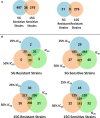Genome-Wide Functional and Stress Response Profiling Reveals Toxic Mechanism and Genes Required for Tolerance to Benzo[a]pyrene in S. cerevisiae
- PMID: 23403841
- PMCID: PMC3567348
- DOI: 10.3389/fgene.2012.00316
Genome-Wide Functional and Stress Response Profiling Reveals Toxic Mechanism and Genes Required for Tolerance to Benzo[a]pyrene in S. cerevisiae
Abstract
Benzo[a]pyrene (BaP) is a ubiquitous, potent, and complete carcinogen resulting from incomplete organic combustion. BaP can form DNA adducts but other mechanisms may play a role in toxicity. We used a functional toxicology approach in S. cerevisiae to assess the genetic requirements for cellular resistance to BaP. In addition, we examined translational activities of key genes involved in various stress response pathways. We identified multiple genes and processes involved in modulating BaP toxicity in yeast which support DNA damage as a primary mechanism of toxicity, but also identify other potential toxicity pathways. Gene ontology enrichment analysis indicated that DNA damage and repair as well as redox homeostasis and oxidative stress are key processes in cellular response to BaP suggesting a similar mode of action of BaP in yeast and mammals. Interestingly, toxicant export is also implicated as a potential novel modulator of cellular susceptibility. In particular, we identified several transporters with human orthologs (solute carrier family 22) which may play a role in mammalian systems.
Keywords: S-9; benzo[a]pyrene; ontology; resistance; sensitivity; stress; toxicity; yeast.
Figures










Similar articles
-
Benzo[a]pyrene increases DNA double strand break repair in vitro and in vivo: a possible mechanism for benzo[a]pyrene-induced toxicity.Mutat Res Genet Toxicol Environ Mutagen. 2014 Jan 15;760:64-9. doi: 10.1016/j.mrgentox.2013.12.003. Epub 2014 Jan 8. Mutat Res Genet Toxicol Environ Mutagen. 2014. PMID: 24412381
-
Transcriptomic analysis reveals dose-dependent modes of action of benzo(a)pyrene in polar cod (Boreogadus saida).Sci Total Environ. 2019 Feb 25;653:176-189. doi: 10.1016/j.scitotenv.2018.10.261. Epub 2018 Oct 21. Sci Total Environ. 2019. PMID: 30408666
-
Influence of cell cycle on responses of MCF-7 cells to benzo[a]pyrene.BMC Genomics. 2011 Jun 29;12:333. doi: 10.1186/1471-2164-12-333. BMC Genomics. 2011. PMID: 21714911 Free PMC article.
-
Molecular Mechanisms of Action of Selected Substances Involved in the Reduction of Benzo[a]pyrene-Induced Oxidative Stress.Molecules. 2022 Feb 18;27(4):1379. doi: 10.3390/molecules27041379. Molecules. 2022. PMID: 35209168 Free PMC article. Review.
-
Influence of Benzo(a)pyrene on Different Epigenetic Processes.Int J Mol Sci. 2021 Dec 15;22(24):13453. doi: 10.3390/ijms222413453. Int J Mol Sci. 2021. PMID: 34948252 Free PMC article. Review.
Cited by
-
Impact of Hurricane Maria on Drinking Water Quality in Puerto Rico.Environ Sci Technol. 2020 Aug 4;54(15):9495-9509. doi: 10.1021/acs.est.0c01655. Epub 2020 Jul 23. Environ Sci Technol. 2020. PMID: 32640159 Free PMC article.
-
Long-term impact of Hurricane Maria on point-of-use drinking water quality in Puerto Rico and associated potential adverse health effects.Water Res. 2024 Nov 1;265:122213. doi: 10.1016/j.watres.2024.122213. Epub 2024 Aug 3. Water Res. 2024. PMID: 39173351
-
DhDIT2 Encodes a Debaryomyces hansenii Cytochrome P450 Involved in Benzo(a)pyrene Degradation-A Proposal for Mycoremediation.J Fungi (Basel). 2022 Oct 30;8(11):1150. doi: 10.3390/jof8111150. J Fungi (Basel). 2022. PMID: 36354917 Free PMC article.
-
Comparative and mechanistic genotoxicity assessment of nanomaterials via a quantitative toxicogenomics approach across multiple species.Environ Sci Technol. 2014 Nov 4;48(21):12937-45. doi: 10.1021/es503065q. Epub 2014 Oct 22. Environ Sci Technol. 2014. PMID: 25338269 Free PMC article.
-
GFP-fused yeast cells as whole-cell biosensors for genotoxicity evaluation of nitrosamines.Appl Microbiol Biotechnol. 2021 Jul;105(13):5607-5616. doi: 10.1007/s00253-021-11426-4. Epub 2021 Jul 6. Appl Microbiol Biotechnol. 2021. PMID: 34228183
References
-
- Aust A. E., Falahee K. J., Maher V. M., McCormick J. J. (1980). Human cell-mediated benzo(a)pyrene cytotoxicity and mutagenicity in human diploid fibroblasts. Cancer Res. 40, 4070–4075 - PubMed
Grants and funding
LinkOut - more resources
Full Text Sources
Other Literature Sources
Molecular Biology Databases

